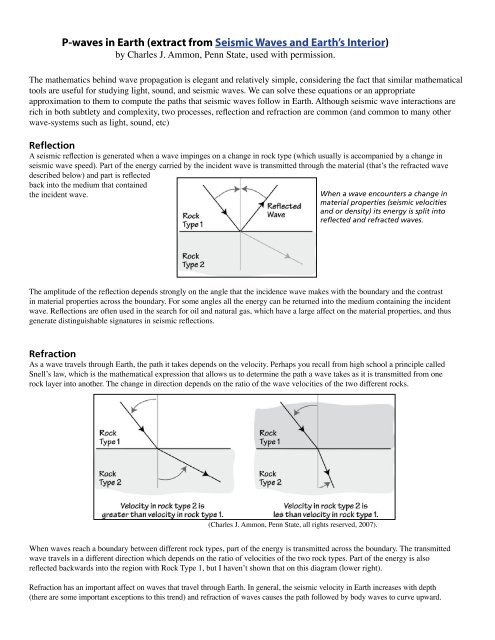Refraction - IRIS
Refraction - IRIS
Refraction - IRIS
You also want an ePaper? Increase the reach of your titles
YUMPU automatically turns print PDFs into web optimized ePapers that Google loves.
P-waves in Earth (extract from Seismic Waves and Earth’s Interior)<br />
by Charles J. Ammon, Penn State, used with permission.<br />
The mathematics behind wave propagation is elegant and relatively simple, considering the fact that similar mathematical<br />
tools are useful for studying light, sound, and seismic waves. We can solve these equations or an appropriate<br />
approximation to them to compute the paths that seismic waves follow in Earth. Although seismic wave interactions are<br />
rich in both subtlety and complexity, two processes, reflection and refraction are common (and common to many other<br />
wave-systems such as light, sound, etc)<br />
Reflection<br />
A seismic reflection is generated when a wave impinges on a change in rock type (which usually is accompanied by a change in<br />
seismic wave speed). Part of the energy carried by the incident wave is transmitted through the material (that’s the refracted wave<br />
described below) and part is reflected<br />
back into the medium that contained<br />
the incident wave.<br />
When a wave encounters a change in<br />
material properties (seismic velocities<br />
and or density) its energy is split into<br />
reflected and refracted waves.<br />
The amplitude of the reflection depends strongly on the angle that the incidence wave makes with the boundary and the contrast<br />
in material properties across the boundary. For some angles all the energy can be returned into the medium containing the incident<br />
wave. Reflections are often used in the search for oil and natural gas, which have a large affect on the material properties, and thus<br />
generate distinguishable signatures in seismic reflections.<br />
<strong>Refraction</strong><br />
As a wave travels through Earth, the path it takes depends on the velocity. Perhaps you recall from high school a principle called<br />
Snell’s law, which is the mathematical expression that allows us to determine the path a wave takes as it is transmitted from one<br />
rock layer into another. The change in direction depends on the ratio of the wave velocities of the two different rocks.<br />
(Charles J. Ammon, Penn State, all rights reserved, 2007).<br />
When waves reach a boundary between different rock types, part of the energy is transmitted across the boundary. The transmitted<br />
wave travels in a different direction which depends on the ratio of velocities of the two rock types. Part of the energy is also<br />
reflected backwards into the region with Rock Type 1, but I haven’t shown that on this diagram (lower right).<br />
<strong>Refraction</strong> has an important affect on waves that travel through Earth. In general, the seismic velocity in Earth increases with depth<br />
(there are some important exceptions to this trend) and refraction of waves causes the path followed by body waves to curve upward.
















